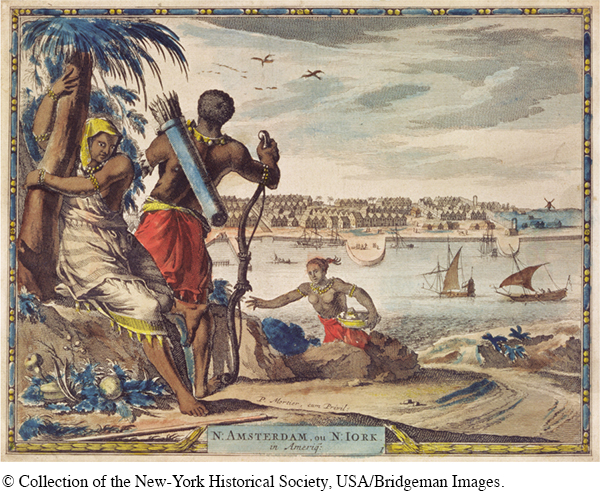From New Netherland to New York
In 1609, the Dutch East India Company dispatched Henry Hudson to search for a Northwest Passage to the Orient. Hudson ventured up the large river that now bears his name until it dwindled to a stream that obviously did not lead to China. A decade later, the Dutch government granted the West India Company—a group of Dutch merchants and shippers—exclusive rights to trade with the Western Hemisphere. In 1626, Peter Minuit, the resident director of the company, purchased Manhattan Island from the Manhate Indians for trade goods worth the equivalent of a dozen beaver pelts. New Amsterdam, the small settlement established at the southern tip of Manhattan Island, became the principal trading center in New Netherland and the colony’s headquarters. [[LP Photo: P04.08 New Amsterdam/
Unlike the English colonies, New Netherland did not attract many European immigrants. Like New England and the Chesapeake colonies, New Netherland never realized its sponsors’ dreams of great profits. The company tried to stimulate immigration by granting patroonships—allotments of eighteen miles of land along the Hudson River—to wealthy stockholders who would bring fifty families to the colony and settle them as serflike tenants on their huge domains. Only one patroonship succeeded; the others failed to attract settlers, and the company eventually recovered much of the land.
Though few in number, New Netherlanders were remarkably diverse, especially compared with the homogeneous English settlers to the north and south. Religious dissenters and immigrants from Holland, Sweden, France, Germany, and elsewhere made their way to the colony. A minister of the Dutch Reformed Church complained to his superiors in Holland that several groups of Jews had recently arrived, adding to the religious mixture of “Papists, Mennonites and Lutherans among the Dutch [and] many Puritans . . . and many other atheists . . . who conceal themselves under the name of Christians.”
The West India Company struggled to govern the motley colonists. Peter Stuyvesant, governor from 1647 to 1664, pointed out to company officials in Holland that “the English and French colonies are continued and populated by their own nation and countrymen and consequently [are] bound together more firmly and united,” while the “colonies in New-Netherland are only gradually and slowly peopled by the scrapings of all sorts of nationalities (few excepted), who consequently have the least interest in the welfare and maintenance of the commonwealth.” Stuyvesant tried to enforce conformity to the Dutch Reformed Church, but the company—eager for more immigrants—declared that “the consciences of men should be free and unshackled,” making a virtue of New Netherland necessity. The company never permitted the colony’s settlers to form a representative government. Instead, the company appointed government officials who established policies, including taxes, that many colonists deeply resented.
In 1664, New Netherland became New York. Charles II, who became king of England in 1660 when Parliament restored the monarchy, gave his brother James, the Duke of York, an enormous grant of land that included New Netherland. The duke quickly organized a small fleet of warships, which appeared off Manhattan Island in late summer 1664, and demanded that Stuyvesant surrender. With little choice, he did.

> CONSIDER CAUSE AND EFFECT
What factors account for the diversity of the New Netherland/
As the new proprietor of the colony, the Duke of York exercised almost the same unlimited authority over the colony as had the West India Company, although the duke never set foot in the colony. Like the Dutch, the duke permitted “all persons of what Religion soever, quietly to inhabit . . . provided they give no disturbance to the publique peace, nor doe molest or disquiet others in the free exercise of their religion.” This policy of religious toleration was less an affirmation of liberty of conscience than a recognition of the reality of the most heterogeneous colony in seventeenth-century North America.
Understanding the American Promise 3ePrinted Page 93
Section Chronology